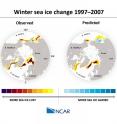NCAR develops method to predict sea ice changes years in advance
Climate scientists at the National Center for Atmospheric Research (NCAR) present evidence in a new study that they can predict whether the Arctic sea ice that forms in the winter will grow, shrink, or hold its own over the next several years. The team of scientists has found that changes in the North Atlantic ocean circulation could allow overall winter sea ice extent to remain steady in the near future, with continued loss in some regions balanced by possible growth in others, including in the Barents Sea.
"We know that over the long term, winter sea ice will continue to retreat," said NCAR scientist Stephen Yeager, lead author of the study published online today in the journal Geophysical Research Letters. "But we are predicting that the rate will taper off for several years in the future before resuming. We are not implying some kind of recovery from the effects of human-caused global warming; it's really just a slow down in winter sea ice loss."
The research was funded largely by the National Science Foundation, NCAR's sponsor, with additional support from the National Oceanic and Atmospheric Administration and the U.S. Department of Energy.
Yeager is among a growing number of scientists trying to predict how the climate may change over a few years to a few decades, instead of the more typical span of many decades or even centuries. This type of "decadal prediction" provides information over a timeframe that is useful for policy makers, regional stakeholders, and others.
Decadal prediction relies on the idea that some natural variations in the climate system, such as changes in the strength of ocean currents, unfold predictably over several years. At times, their impacts can overwhelm the general warming trend caused by greenhouse gases released into the atmosphere by humans.
Yeager's past work in this area has focused on decadal prediction of sea surface temperatures. A number of recent studies linking changes in the North Atlantic ocean circulation to sea ice extent led Yeager to think that it would also be possible to make decadal predictions for Arctic winter sea ice cover using the NCAR-based Community Earth System Model.
Linking ocean circulation and sea ice
The key is accurately representing the Atlantic Meridional Overturning Circulation (AMOC) in the model. AMOC sweeps warm surface waters from the tropics toward the North Atlantic, where they cool and then sink before making a return south in deep ocean currents.
AMOC can vary in intensity. When it's strong, more warm water is carried farther toward the North Atlantic and Arctic oceans, accelerating sea ice loss. When weak, the warm water largely stays farther south, and its effects on sea ice are reversed. The variations in AMOC's vigor--from weak to strong or vice versa--occur over multiple years to decades, giving scientists some ability to predict in advance how it will affect winter sea ice, in particular.
AMOC now appears to be weakening. Yeager and his co-authors, NCAR scientists Alicia Karspeck and Gokhan Danabasoglu, found in their new study that this change in the ocean is likely to be enough to temporarily mask the impacts of human-caused climate change and stall the associated downward trend in winter sea ice extent in the Arctic, especially on the Atlantic side, where AMOC has the most influence.
The limits of a short satellite record
The amount of sea ice covering the Arctic typically grows to its maximum in late February after the long, dark winter. The sea ice minimum typically occurs at the end of the summer season, in late September. The new study addresses only winter sea ice, which is less vulnerable than summer ice to variations in weather activity that cannot be predicted years in advance, such as storms capable of breaking up the ice crust.
Despite their success incorporating AMOC conditions into winter sea ice "hindcasts," the scientists are cautious about their predictions of future conditions. Because satellite images of sea ice extend only back to 1979, the scientists had a relatively short data record for verifying decadal-scale predictions against actual conditions. Additionally, AMOC itself has been measured directly only since 2004, though observations of other variables that are thought to change in tandem with AMOC--such as sea surface height and ocean density in the Labrador Sea, as well as sea surface temperature in the far North Atlantic--go back much farther.
"The sea ice record is so short that it's difficult to use statistics alone to build confidence in our predictions," Yeager said. "Much of our confidence stems from the fact that our model does well at predicting slow changes in ocean heat transport and sea surface temperature in the subpolar North Atlantic, and these appear to impact the rate of sea ice loss. So, we think that we understand the mechanisms underpinning our sea ice prediction skill."
Source: National Center for Atmospheric Research/University Corporation for Atmospheric Research
Other sources
- New method to predict sea ice changes years in advancefrom Science DailyWed, 9 Dec 2015, 19:52:32 UTC
- NCAR to develop wildland fire prediction system for Coloradofrom PhysorgWed, 9 Dec 2015, 19:11:48 UTC
- NCAR develops method to predict sea ice changes years in advancefrom PhysorgTue, 8 Dec 2015, 19:40:50 UTC
- NCAR Develops Method to Predict Sea Ice Changes Years in Advancefrom Newswise - ScinewsTue, 8 Dec 2015, 17:22:40 UTC
